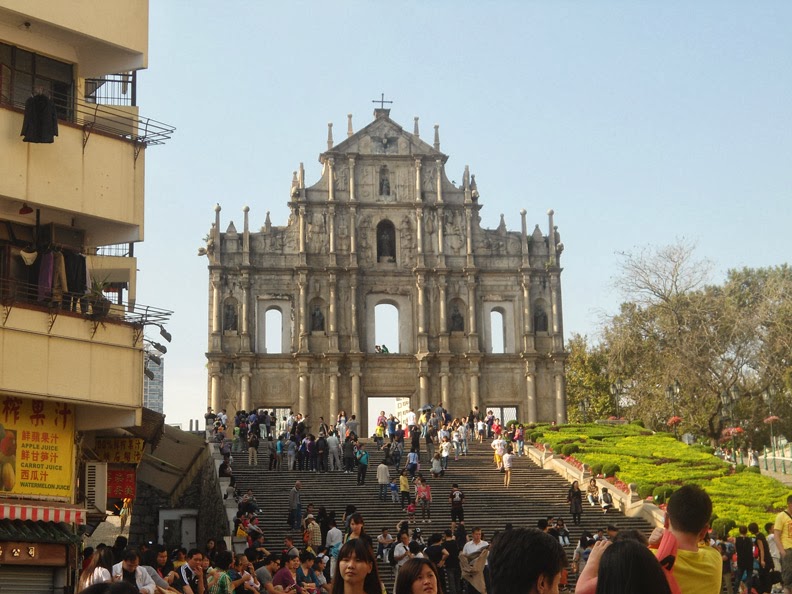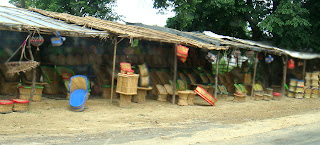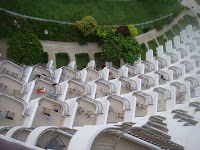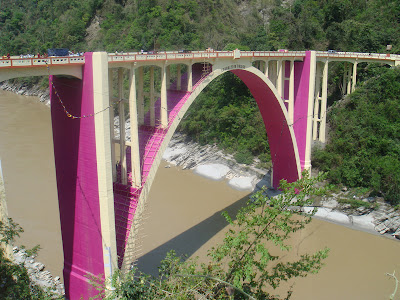Yes, so popular is MICE tourism getting that operators, both global and domestic, are going all out to ensure that all whims of the well paying and increasingly frequent Indian client
 |
The ruins of St Paul in Macau, a top MICE destination
out of India |
Unlike most perceptions about MICE travel, it is not a new practice for AB Pal, a dealer for electric equipment giant Havell’s. Except once when he was not well, this Bhagirath Place, Delhi-based dealer, has not missed any of the company’s trips over the past 37 years! Though he admits they have taken really off in the last seven or eight years. “The trips are advantageous both for business and leisure,” he beams. There are clear business advantages, he says. “On the last trip, about 650 dealers from across India had gone to Macau. I knew only about 50 of them personally. So this was a good opportunity to meet the others. In our business, there is often a sudden requirement, and then you can tap a dealer you know to meet the customer requirement.” The leisure purposes are also met. “We go with our families, and the ladies like to travel. They were very surprised and pleased to have chaat and golgappas in Macau.” The organizers had also flown Bollywood stars Bappi Lahiri and Anant Mahadevan, and this made our spouses very excited, he says. “They carry cooks who can prepare food even for the fussy Indian, who wants his kadi chawal or can prepare food by specific instructions.” No wonder MICE is popular!
 |
| Setting up to meet 4,000 at a meal in Melbourne's Convention Centre |
The company benefits too. Vijay Narayanan, vice-president, marketing and communications, Havell’s, says the trips serve to bond between the dealers and the customers. “There are open meetings between the top management of the company and the dealers, and concerns are discussed in open forums. There are also awards presentations, ‘gala’ nights and a lot of entertainment” A lot of queries get sorted out, and a relationship gets built, which has stood the company in good stead over the decades. While the initial trips costs little and were domestic, last year the company spent about Rs 15 crore. “There are usually two to three trips a years, for about 600 dealers each that last for about a week,” he says. The destinations depend on the level of dealers and achievements.
Vinayak Kumar Lal, GM-Marketing, Intex Technologies, a 15-year-old IT company, agrees, saying his company spends about 3 per cent of the marketing budget on MICE as it clearly helps business. “We generally go twice a year, which depends on the rewards or schemes.”
 |
| All set for a conference at Singapore's Resorts World in Sentosa |
Karan Anand, Head, Relationships, Cox and Kings Ltd says the MICE industry is growing at 30 per cent both from the inbound and outbound perspective. “Indian corporate houses eager to keep their high performing employees, dealers and associates happy, are wooing them with exotic holiday options. It may be a cruise on the Bahamas or a stay at the Burj Al Arab in Dubai there is enough demand.” He says that “at the lower end, people travel to Thailand, Sri Lanka and Nepal. This is followed by Singapore, Malaysia, Hong Kong, Macau and Dubai. The more exotic ones travel to Istanbul, Australia etc.” The budget, he says, varies from Rs 60,000 per person to up to Rs 2 lakh per person.
Kashmira Commissariat COO Outbound Division Kuoni India travel is perhaps the most preferred leisure activity, and travel incentive products serve as immense motivation for internal and external customers. “They have great inspirational value, and those who qualify for overseas trips tend to perform better than their peers.” She points out that the average numbers of trips vary according to the different industries. For instance: pharmaceutical industry arranges multiple number of MICE trips, whereas insurance industry arranges the trip on half yearly basis.
Stephane Fabregoul, General Manager, The Westin Hyderabad Mindspace, says the trend is still emerging with various industries performing in different months. “Conferences is a budgeted head in companies across industries. Hyderabad also has a significant share of international conventions, which is poised to grow with the launch of Visit Hyderabad – Hyderabad Convention Promotion Bureau. Large inventories coupled with matching infrastructure help generate demand for larger conventions.”
While cements, paints, FMCG, are industries that are spending more, sectors like pharma and mutual funds have reduced their spend, Keyur Joshi, COO and Co-founder, MakeMyTrip.com. he classifies company budgets and average spends as follows:
Category 1 =
Rs.10 – 20K (Usually domestic)
Category 2 =
Rs.25 – 35K (Usually one stop destinations like Far East/Middle East)
Category 3 =
Rs.40 – 60K (Usually Bali, Turkey, Egypt, HongKong & Macau, Philippines)
Category 4 =
Rs.60 – 80K (France, Switzerland, Italy, South Africa)
Category 5 =
Rs.100k + (Australia, USA)
Incentives, exhibitions…
 |
| At an exhibition and conference in Manila's Convention Centre |
Incentive tourism is often still the biggest within the MICE segment, especially as infrastructure within India does not match up the rest of the region. Incentive tourism is big for us, says Amanpreet Bhatia of MSC Cruises. He points to the advantages cruises have for corporate clients. “Cruises give time for people to interact, provide 5-star luxury, a captive audience and a one vendor contact, all of which make it easier for the client.” He says that cruises are an increasingly popular option for Indians. The choice of destination is considerable, and this depends on the time and value. Food is a major concern for Indians, he admits, but also points out that adequate care is taken to provide for food. While the charge per night ranges from Rs 6,000 to Rs 15,000, the usual tariff is about Rs 10,000 to 12,000.
MICE often ventures into the more offbeat as well. Team building is what Colonel Nirmal Mahajan, who runs an outdoor adventure company, Colonels' Adventure, says is the biggest benefit that those participating derive. “The best place to learn is at rafting camps, where they get a lot of time to bond,” he says, explaining that among the benefits are the development of calculated risk taking ability, team spirit, decisiveness and physical and mental toughness. “A lot of people who want to get away from the 5-star culture come to our camps,” he points out.
Priority for hotels
For hotels too, MICE generates considerable business. “About 15 to 20 per cent of our revenue comes from MICE, points out Roger Wright, General Manager, The Leela Kempinski, Gurgaon. Given that this hotel is adjacent to a mall in a business district and near the airport, it is unabashedly a business hotel and caters to the high end of the meetings markets – board meetings and conferences. “A lot of the MICE business comes from northern India, and it is an absolutely vital market for us,” he stresses.
“MICE is key to the survival and growth of hospitality,” sats Pradeep Kalra, Senior Vice President, Sales & Marketing, Sarovar Hotels. “We have mid scale hotels, with a stress on conference facilities. “15 to 2- per cent of our revenues come from MICE.” He points out that leisure locations derive more from the MICE segment due to its very nature such as the requirement for a conference with residential facilities, only city hotels can cater to really large conference that have about 10,000 people attending. He points to the opportunities in cities such as Hyderabad and Bangalore. In the latter Sarovar is coming up with a 234 room Park Plaza. Certain hotels such as Taj Palace, is a popular MICE destination with the capital’s largest conference venue and luxury convention centre, offering a cumulative 40,000 sq feet. Renowned large scale conferences such as the World Economic Forum, World Atomic Nuclear Organization and Global Steel Conference among others have opted for it. It has been named as ‘Asia’s leading meeting and conferences hotel’ at the 17th World Travel Awards 2010 and awarded the India’s Leading Conference Hotel by World Travel Awards 2009 Asia.
Hotels outside India are as eagerly looking at Indian market. Oliver Bonke, Senior Vice President, Sales & Marketing, Starwood Hotels & Resorts, Europe, Africa and Middle East says 30 per cent of its overall business comes from MICE. Europe is a major incentive market for Indians, he points out. “Sectors such as pharmaceuticals, construction and finance are choosing their destinations in our region, pointing out that industry conferences too have significant Indian presence.
“An innovative approach to conventions like the signature Westin Clutter Free meetings and the meetings concierge can help drive the demand of conferences across hotel categories,” says Stephane Fabregoul of Westin, Hyderabad. “MICE is a potential growth segment for hotels, which drives both the occupancy, and thereby the RevPAR of the hotel. As India Inc reports higher profitability and returns, they tend to spend more on MICE through new launches, dealer meets, sales incentives, review meetings and the like.”
Travel company Yatra.com set up a dedicated section for MICE from April last year. Narendra Singh, Head, MICE Business, Yatra.com points to the popularity and growing importance of the segment. “Both domestic and international destinations have potential.” He points to the advantages dedicated teams like his have to offer for clients. “If a client is spending a crore, he wants it to be in safe, experienced hands. If you hand over the conference to a professional team, the responsibility goes to them for everything. As MICE PRs, we are cost effective, and have established relationships with channel partners.” He says that different clients have varying demands, and meeting them is a challenge.
Meeting far and wide
 |
| Entertainment is a significant part of conventions globally |
Many global destinations are actively promoting themselves as MICE destinations. “There are many destinations presently that are packaging and promoting themselves as MICE destinations,” says MakeMyTrip.com’s Keyur Joshi. Some of the popular ones are: Hua Hin in Thailand, Bali in Indonesia, Manila in Philippines, Cape Town in South Africa, Tashkent in Uzbekistan, Macau, Spain apart from the traditional favourites Singapore, Dubai and Malaysia. Kuoni India’s Kashmira Commissariat says the preferred destinations at the moment are Dubai, Thailand, Kenya and Africa. Cox and Kings’ Karan Anand points out Australia, Macau, Singapore, Malaysia, Turkey and Hong Kong as the destinations promoting MICE very aggressively.
According to Hotels.com’s Hotel Price Index, prices paid in Asia Pacific, and their pace of recovery, shows clear variations across the region, points out Abhiram Chowdhry, Marketing Director- Asia Pacific, Hotels.com. “Large business and convention hubs, like Singapore and Hong Kong, have seen rates go up on the back of returning corporate travel demand.” According to the report, Singapore tops the biggest rise list - Indian travellers spent Rs.7,949 per room per night (up 27% from the same period a year earlier). With new conference facilities development in Macau, Vietnam, Hainan and Shanghai in China, these places are one of the new emerging popular MICE locations, he says.
The most popular city for MICE in Turkey is Istanbul and it offers many attractions for a MICE group, says a Angelina Ambrose of the Turkish Culture & Tourism Office. “Istanbul not only boasts excellent convention facilities with many world class heritage sites but also offers excellent dining and night life options too. Apart from Istanbul, beach city of Antalya and cave city of Cappadocia are getting popular with India MICE groups. There have been many groups ranging from 50 –500 persons and the average stay of the groups is about 3 to 4 nights in Istanbul.
Another favourite is Singapore, an award winning BTMICE destination, points out Jessica Sim, Area Director, Northern-Eastern India, Singapore Tourism Board. “The MICE market makes up a sizeable portion of our visitor arrivals, with a share of around 35% of total Indian arrivals. Singapore assures an enriching experience with an excellent range of state-of-the-art convention centers, exhibition halls and meeting spots to suit a variety of needs and budgets along with the convenience of nearby accommodation and dining. In the recently organized CEI Asia Industry Awards 2010, Singapore was announced as Asia’s Best City for Business Events and Asia’s Best Convention Bureau.” India is a significant market for Singapore and continues to remain as one of the top five visitor generating markets for the city-state. India recorded a whopping 829,000 visitor arrivals for the period January to December 2010, she says.
The Singapore tourism industry entered a watershed era in 2010 with the opening of two magnificent integrated resorts namely Resorts World Sentosa and Marina Bay, she underlines. “With the grand opening of integrated resorts, Singapore offers the Indian MICE segment a unique opportunity to organize a complete getaway with hotels, fine dining, shopping, entertainment and nightlife options as well as meetings and incentive facilities. Venues to hold corporate events at the Marina Bay Sands include a grand ballroom that can hold at least 6,600 people (one of the largest in Asia) or an exhibition hall which can accommodate approximately 2,000 exhibition booths and a flexible convention centre comprising more than 200 meeting rooms with capacity for over 45,000 delegates. At Resorts World Sentosa, themed functions among dinosaurs at ‘The Lost World’ and a gala dinner dressed up as movie characters at Universal Studios, is a hot favourite.”
Thailand is the premier destination for MICE tourism out of India, stresses Sheema Vohra,
Representative – India, Thailand Convention and Exhibitions Bureau. She says there are no separate numbers for the MICE market, but many want MICE packages – usually a half day conference, gala dinner, award function, followed by leisure activities. “There is a growing interest from India in group activities within the MICE segment,” she says. She points to the advantages that makes Thailand the top destination – quick access from India, flights from different parts of the country, ease of visa regulations and excellent infrastructure. While Bangkok as the international gateway remains popular along with Pattaya, other emerging destinations include Phuket, Kosa Mui and Chiang Mai. “Indians are ready to spend, and they usually for 4 or 5 star hotels for their stays,” she says.
Time to upgrade
India is still not seen as a MICE destination, bemoan most travel professionals. Sarovar Hotels’ Pradeep Kalra admits India will take to match the amenities South east Asia offers in terms of MICE infrastructure. “India is getting there, we have good accessibility, good food, tremendous sight seeing options, and rapidly improving infrastructure, so it should not be too long before we catch up,” he says.
“India’s infrastructure is insufficient and the government is not taking adequate steps, says Yatra.com’s Narendra Singh. He points out the even on the Golden Triangle circuit, India’s top domestic tourist earner, there are hardly any facilities for clean drinking water and restrooms. “Even if the government can see to it that these two facilities are in place, there could be a quantum leap in the number of travelers, even for MICE.”
“India’s MICE sector is fast gaining its pace with the advanced technology and facilities being made available at a better cost than many other countries,” Abhiram Chowdhry of Hotels.com. says Simplified visas and greater accessibility (including both local infrastructure and new regional air services) are helping India to become an emerging MICE destination in Asia’.
If all the concerned players can act in concert, that day could come sooner rather than later.
Suman Tarafdar
(This article was published in Business India in March 2011)





































